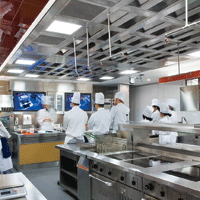Few chefs are passionate about them, but ventilation and exhaust systems are significant investments with a complexity that deserves attention
The adage says if you can’t handle the heat, get out of the kitchen, but maybe it’s just time to re-examine your ventilation and exhaust system.
While a good ventilation system is a kitchen essential, it’s not often a chef ’s favourite piece of equipment. “They’re not exactly one of those pieces that chefs go gaga over,” says Mikael Volke, culinary instructor, School of Hospitality and Tourism at SAIT Polytechnic in Calgary. “A ventilation system is one of those things you don’t think about until it doesn’t work. Then you really think about it.”
Almost every operator and consultant will agree ventilation represents one of the biggest kitchen challenges, largely because it involves complicated engineering know-how and comprises the lion’s share of any equipment budget. “It’s one of the largest cans of worms for operators. Systems are more engineer driven, more complicated and have more controls,” says Andre Trevino, project design engineer for Russell Food Equipment in Vancouver.
A new top-of-the-line “fully loaded” system can cost upwards of $100,000, including the makeup air unit.
Even a standard base package can set an operator back $30,000. But start adding ecology boxes, controls and computer modules, and the price can skyrocket quickly.
Keeping it Simple
When chef John Cirillo opened his Culinary Academy in Toronto, he drew on years of experience as an executive chef with Hilton Hotels to plan his ventilation system. While engineers are the key to good equipment selection and installation, Cirillo got involved in the day-to-day issues of the system’s operation, “because it is critical to your working environment,” he says. “If it’s not extracting and doing what it’s supposed to do, the heat, the smells and the noise can make for a very stressful kitchen.”
Cirillo confirms the ventilation and exhaust system is probably the most expensive capital investment in a foodservice business. “Most restaurateurs don’t have a grasp of the costs,” he adds. At the Academy, he uses a seven-hood custom system that runs on one switch. For the most part, Cirillo stuck to basics, choosing a system with a quiet fan and a simple on-off mechanism with no bells and whistles. “For me, that works,” he says.
The final bill came to about $150,000. “I learned a few things. One, stainless steel is not expensive — that accounts for about $15,000 to $20,000. What does get expensive is the rooftop unit, fire suppression and the welded ductwork, return air unit and fan. We had to pay for a crane to get the unit on the roof. That was up to $1,000 alone.”
Brad Long of Toronto’s Belong Café is equally pragmatic about his ventilation needs. “There’s nothing too dandy about the Spring Air system here. We have a good solid hood with a good high-efficiency makeup air system, which is warmed by the same glycol unit that warms the floor.”
He decided against a demand ventilation system that allows variable control of airflow based on one’s needs, because it wasn’t necessary for his operation. “It’s not so much on demand as low demand,” he explains. “It doesn’t have the halogen lighting; there is nothing weird about it. The point was to have something dead simple: a very short run and no welded plenum. Since we don’t do a lot of deep frying there’s not much grease in the air, so we don’t need ecologizer units.”
Nonetheless, the cost still accounted for most of the construction budget. “Unless you’ve invested in pearl-handled appliances, mechanical/ electrical is without a doubt your biggest cost. I’ve built enough restaurants in stadiums, high-rise towers and other places to know that no matter how simple the building, it’s still by far the most expensive aspect,” says Long.
Free-Flowing Innovation
While he stuck to the basics with his system, Cirillo has seen a lot of innovation on the ventilation front. “Systems have come so far. Some blend into ceilings, like the one at [Toronto’s] Humber College.”
In 2005, Humber’s School of Hospitality, Recreation and Tourism was the first in Canada to install the Halton Vent Master ceiling system from Europe. According to Rudolf Fischbacher, professor and coordinator of Culinary Programs, the system continues to garner awards and draw enquiries from operators. “When compared to a traditional hood system, this one is much quieter. It runs at 20 to 25 decibels as opposed to 50 or 60.” The system also changes the air in the room five times an hour to ensure greater distribution to the entire room.
Despite its sophistication, it’s very simple to clean and maintain. “The stainless steel filters are tucked into the ceiling; you just pop them out and put them through the dishwasher,” explains Fischbacher. “And, if you want to move equipment from one area to the other, you can move dampers around like Lego blocks to change the airflow.”
Meeting Demand
While not everyone needs high-end features, Doug Feltmate, president of Ottawa’s consulting and design firm, Designed Food Systems, is a die-hard demand ventilation proponent. “Pretty well all the major manufacturers offer it, whether you are working with a Melink, Spring Air or Halton M.A.R.V.E.L. system. They’re a bit different in terms of how they work — some are more finely tuned or have a higher range. But they all sense heat, smoke and other elements and go up and down automatically as the demand requires.”
He estimates demand ventilation can reduce energy costs by as much as 40 per cent. “Usually operators will see a return on investment (ROI) in one to three years based on energy savings.” The price premium for demand ventilation could run anywhere from $6,000 to $30,000, depending on the features or functions selected. But, while the cost premium might deter some operators, the right selling proposition will woo others. Customers are drawn to these machines because they offer a ROI as well as a footprint reduction. “Chains tend to look at ROI. If it meets the criteria; it’s automatically done. Institutional operations also look at ROI, but a lot are also working to be LEED-compliant or certified. In that case the premium is worth the innovation points achieved. In fine dining, it really comes down to the culture and attitude of the owner.”
Finding the right system requires some homework. Operators should estimate the number of exhaust hoods and fans required, because that will determine how many digital controllers are needed. “While a digital control system might cost more, you can save quite a bit in ducting and exhaust fans,” because you can use one fan for multiple hoods, for example, Feltmate says. On the other hand, it’s a little different when operators use higher-end systems. “A large production centre might have nine hoods running off one fan unit, with each having a control damper so they can work at different volumes,” he explains.
Hood design has also changed. These days hoods feature curved interiors to improve airflow or air curtains that make them bigger and capture smoke and heat better. Filters have also improved from 40-per-cent to 90-per-cent efficiency, which reduces how often operators have to clean ducts and minimizes fire-hazard situations. Feltmate contends that retrofits can be applied to most systems that have been built in the last 10 years. Costs can vary but generally start at approximately $8,000.
While the industry has become incredibly sophisticated, Feltmate predicts further innovation. “[Soon] technology will have an algorithm that can determine when an operation starts to get busy. Rather than waiting for heat to be generated, it will start as soon as there’s an increase in gas or electric usage,” the consultant says. He expects systems will also understand business patterns and automatically send notices to the operator if an appliance is left on during a down period. “In a matter of 10 years, it won’t be a steel box hung off a roof — it will literally be a smart system.”
Vendor Information
For a complete supplier’s list, check our Buyer’s Guide.
More in Feature Articles
Kicking it Up a Notch: How to Add a Modern Twist to Traditional Italian Food
Making it Big: Extreme Brandz Takes the Lead
A League of Their Own: MLSE Scores Big
The C Factor: Chef Clark Champions the Canadian Seafood Industry
Hot Spot: Profiling Vancouver’s White Spot Resto
House Rules: Profiling Paul Rogalski and Olivier Reynaud of Rouge
Rise Up: Canadian Wines Shine on Restaurant Menus
Russo Rising: Profiling Chef Russo





















